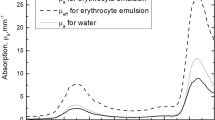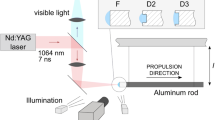Abstract
The objective of this study was to describe the dynamics of water heating carried out by continuous laser radiation with wavelengths 1.47, 1.55, and 1.94 μm with different types of fibers used for endovenous laser coagulation. The study was conducted in water using high-speed surveying of the heating process through the shadow optical method. It has been shown that in the case of highly water-absorbed laser radiations, convection and boiling play a major role in the process of heat transfer. It has been shown that in the case of radiation with λ = 1.94 μm that is heavily absorbed by water, effective heat transfer begins at significantly lower levels of power compared to the weaker-absorbed radiations with λ = 1.47 and 1.55 μm. Mathematical models based only on thermal conductivity inadequately describe the process of real heat transfer during endovenous laser coagulation. It has been established that heat transfer is sharply asymmetrical and is directed mainly up-and-forward (bare-tip fiber) or upward (“radial” and “two-ring” fibers). Heat transfer for laser light with wavelength 1.94 μm is most effective than for 1.47 and 1.55 μm.







Similar content being viewed by others
References
Shimechko OS, Chehovskiy AO, David VM (2014) Comparison of EVLT by lasers with different wavelengths. Materials of the scientific-practical conference “Introduction of modern innovative technologies in minimally invasive laser interventions: clinical, economic and technical aspects” Ukraine. 121–123 [in Ukr.]
Cerrati EW, MArch TMO, Chung H, Waner M (2015) Diode laser for the treatment of telangiectasias following hemangioma involution. Otolaryngol - Head Neck Surg (U S) 152:239–243. https://doi.org/10.1177/0194599814559192
Mendes-Pinto D, Bastianetto P, Cavalcanti Braga Lyra L et al (2016) Endovenous laser ablation of the great saphenous vein comparing 1920-nm and 1470-nm diode laser. Int Angiol 35:599–604
Schmedt C-G, Esipova A, Dikic S et al (2016) Endovenous laser therapy (ELT) of saphenous vein reflux using thulium laser (Tm, 1940 nm) with radial fiber – one year results. Eur J Vasc Endovasc Surg 52:413–414. https://doi.org/10.1016/j.ejvs.2016.07.071
Lawson JA, Gauw SA, van Vlijmen CJ et al (2018) Prospective comparative cohort study evaluating incompetent great saphenous vein closure using radiofrequency-powered segmental ablation or 1470-nm endovenous laser ablation with radial-tip fibers (Varico 2 study). J Vasc Surg Venous Lymphat Disord 6:31–40. https://doi.org/10.1016/j.jvsv.2017.06.016
Proebstle TM, Lehr HA, Kargl A et al (2002) Endovenous treatment of the greater saphenous vein with a 940-nm diode laser: thrombotic occlusion after endoluminal thermal damage by laser-generated steam bubbles. J Vasc Surg 35:729–736. https://doi.org/10.1067/mva.2002.121132
Zhilin KM, Minaev VP, Sokolov AL (2009) Effect of laser radiation absorption in water and blood on the optimal wavelength for endovenous obliteration of varicose veins. Quantum Electron 39:781–784. https://doi.org/10.1070/qe2009v039n08abeh014071
Stokbroekx T, De Boer A, Verdaasdonk RM et al (2014) Commonly used fiber tips in endovenous laser ablation (EVLA): an analysis of technical differences. Lasers Med Sci 29:501–507. https://doi.org/10.1007/s10103-013-1475-2
Mordon SR, Wassmer B, Zemmouri J (2007) Mathematical modeling of 980-nm and 1320-nm endovenous laser treatment. Lasers Surg Med 39:256–265. https://doi.org/10.1002/lsm.20476
Ignatieva NY, Zakharkina OL, Masayshvili CV et al (2017) The role of laser power and pullback velocity in the endovenous laser ablation efficacy: an experimental study. Lasers Med Sci 32:1105–1110. https://doi.org/10.1007/s10103-017-2214-x
Poluektova AA, Malskat WSJ, Van Gemert MJC et al (2014) Some controversies in endovenous laser ablation of varicose veins addressed by optical-thermal mathematical modeling. Lasers Med Sci 29:441–452. https://doi.org/10.1007/s10103-013-1450-y
Artemov SA, Belyaev AN, Bushukina OS, et al (2019) Optimization of endovenous laser coagulation: in vivo experiments. Lasers Med Sci 9–12. https://doi.org/10.1007/s10103-019-02874-6
Artemov S, Belyaev A, Bushukina O, et al (2019) Endovenous laser coagulation using two-micron laser radiation: mathematical modeling and in vivo experiments. In: Book of Abstracts «International Conference on Advanced Laser Technologies (ALT’19)». https://doi.org/10.24411/9999-011A-2019-00154
Disselhoff B, Rem AI, Verdaasdonk RM et al (2008) Endovenous laser ablation: an experimental study on the mechanism of action. Phlebology 23:69–76
Neumann HAM, Van Gemert MJC (2014) Ins and outs of endovenous laser ablation: afterthoughts. Lasers Med Sci 29:513–518. https://doi.org/10.1007/s10103-013-1499-7
Chudnovskii V, Mayor A, Kiselev A, Yusupov V (2018) Foaming of blood in endovenous laser treatment. Lasers Med Sci 33:1821–1826. https://doi.org/10.1007/s10103-018-2552-3
Chudnovskii VM, Yusupov VI, Dydykin AV et al (2017) Laser-induced boiling of biological liquids in medical technologies. Quantum Electron 47:361–370. https://doi.org/10.1070/qel16298
Minaev VP, Minaev NV, Bogachev VY, et al (2020) Heat transfer in water at laser heating through optic fibers for endovenous laser coagulation. Quantum Electron 50:793-800. https://doi.org/10.1070/QEL17226
Marchenko AA, Minaev VP, Smirnov IV, Shevelkina ED (2019) Evaluation of blood optical properties in the wavelength range of 1.3–2.0 μm. Laser Med 23:44–51 (In Russ.)
Elhilali MM, Badaan S, Ibrahim A, Andonian S (2017) Use of the Moses technology to improve holmium laser lithotripsy outcomes: a preclinical study. J Endourol 31:598–604
Funding
This work was supported by the Ministry of Science and Higher Education within the State assignment Federal Scientific Research Centre “Crystallography and Photonics” Russian Academy of Sciences in part of development of laser technologies and Russian Foundation for Basic Research (Project No. 18-29-06056) in part of laser ablation.
Author information
Authors and Affiliations
Contributions
Vladimir P. Minaev suggested a basic research concept and made substantial contributions to acquisition of data and interpretation of data; Nikita V. Minaev made substantial contributions to the development and assembly of the experimental setup and obtaining results; Vadim Yu. Bogachev made substantial contributions to the analysis of the results obtained and to the discussion of the determination of laser exposure regimes; Konstantin A. Kaperiz has made substantial contributions to the data collection and interpretation and preparation of laser exposure modes similar to those used in the clinic; Vladimir Yusupov has made substantial contributions to conception and design, analysis, and interpretation of data.
Corresponding author
Ethics declarations
Conflict of interest
The authors declare that they have no conflict of interest.
Role of funding source
The support of the funding source regarding research in the development of new laser technologies is provided by providing the necessary scientific equipment and measuring stands. Scientific grant support allowed access to the latest laser and diagnostic equipment.
Ethical approval
Because of the study design as a modeling of physical processes, ethical approval was not necessary.
Additional information
Publisher’s note
Springer Nature remains neutral with regard to jurisdictional claims in published maps and institutional affiliations.
Rights and permissions
About this article
Cite this article
Minaev, V.P., Minaev, N.V., Bogachev, V.Y. et al. Endovenous laser coagulation: asymmetrical heat transfer (modeling in water). Lasers Med Sci 36, 1599–1608 (2021). https://doi.org/10.1007/s10103-020-03184-y
Received:
Accepted:
Published:
Issue Date:
DOI: https://doi.org/10.1007/s10103-020-03184-y




